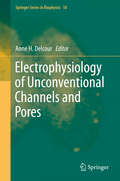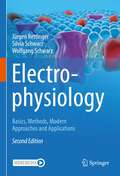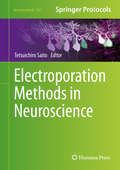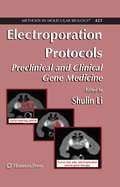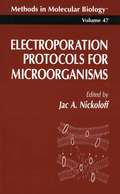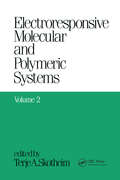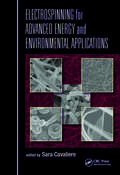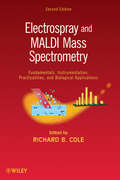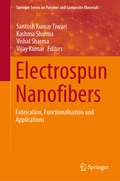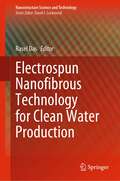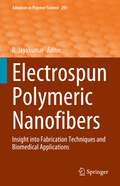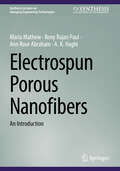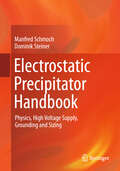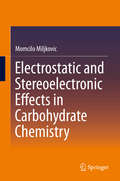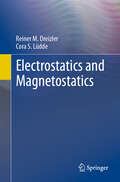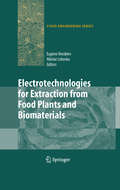- Table View
- List View
Electrophysiology of Extraocular Muscle: With Special Reference to Electromyography
by Goodwin M. BreininIn this review of the electrophysiology of extraocular muscle, Dr. Breinin gives particular attention to the scientific literature on ocular electromyography. This literature is quite recent but the bibliography is growing at a rapid rate. Fundamental advances in the knowledge of extraocular muscle function in health and disease have accrued in the investigations being conducted in many laboratories and the author provides a comprehensive summary of information on the theoretical and practical applications of electromyography to the extraocular muscles and the contributions of the technique to the general problem of strabismus. Controversial observations are discussed at length, experimental studies are reported, and new bio-electronic computing techniques are described. Recent studies from the author's laboratory on the physiologic and pharmacologic properties of extraocular muscle are also described.The study is issued under the sponsorship of the American Ophthalmological Society.
Electrophysiology of Unconventional Channels and Pores
by Anne H. DelcourThis book is dedicated to the channels and pores that belong to an eclectic and ubiquitous class of unconventional - perhaps at times strange - pore-forming molecules, which nevertheless play fundamental roles in various organisms. These non-canonical channels may take on various and sometimes complex architectures, such as large beta-barrels or lipid-containing pores. They may originate from bacteria, viruses or intracellular organelles. For some of them, the physiologically relevant substrate may indeed be ions, and for others folded polypeptides. Some are released by cells in a soluble form that has the ability to insert into biological membranes to exert its permeabilizing effect. Many of these unconventional pores have been investigated by electrophysiology, which, by its virtue of focusing on a few or even a single unit, has provided invaluable insight into the mechanisms and structure-function relationships of these remarkable membrane entities. The chapters of this book highlight a representative set of these interesting investigations.
Electrophysiology of Unconventional Channels and Pores (Springer Series in Biophysics #18)
by Anne H. DelcourThis book is dedicated to the channels and pores that belong to an eclectic and ubiquitous class of unconventional - perhaps at times strange - pore-forming molecules, which nevertheless play fundamental roles in various organisms. These non-canonical channels may take on various and sometimes complex architectures, such as large beta-barrels or lipid-containing pores. They may originate from bacteria, viruses or intracellular organelles. For some of them, the physiologically relevant substrate may indeed be ions, and for others folded polypeptides. Some are released by cells in a soluble form that has the ability to insert into biological membranes to exert its permeabilizing effect. Many of these unconventional pores have been investigated by electrophysiology, which, by its virtue of focusing on a few or even a single unit, has provided invaluable insight into the mechanisms and structure-function relationships of these remarkable membrane entities. The chapters of this book highlight a representative set of these interesting investigations.
Electrophysiology: Basics, Methods, Modern Approaches and Applications
by Wolfgang Schwarz Jürgen Rettinger Silvia SchwarzThis updated and revised textbook presents a broad overview on topics concerning cellular electrophysiology – ranging from bioelectric phenomena recognized as far back as ancient Egypt to popular topics on the dangers of electrosmog. Without sacrificing scientific precision, this clear and concise work presents on the one hand the different methods and modern applications, on the other hand the biophysical fundamentals of ion-channel and carrier proteins. Numerous and carefully selected illustrations and diagrams supplement the text. Each chapter is extended by a detailed table of Take-Home Messages. Questions at the end of each chapter allow readers to test their understanding. Each section also includes references to relevant original literature for further reading. The book offers a valuable resource for students of biology, chemistry and physics with a special interest in biophysics.
Electroporation Methods in Neuroscience
by Tetsuichiro SaitoThis volume describes the methods of both in vivo and in vitro electroporation using ferrets, rats, mice, chickens, and zebrafish. Recent advances of experiments using the tetracycline-regulated gene expression and Tol2 transposon systems are also included. Written in the popular Neuromethods series style, chapters include the kind of detail and key advice from the specialists needed to get successful results in your own laboratory. Practical and authoritative, Electroporation Methods in Neuroscience serves to aid scientists in the further study into this crucially important way to study cells.
Electroporation Protocols
by Shulin LiIn this volume, top researchers provide hands-on protocols describing the process of non-viral delivery of genetic materials such as DNA in order to better treat disease. Each method and protocol offers step-by-step, readily reproducible laboratory instructions, with the benefit of several introductory reviews to aid investigators new to this exciting technology. Notes on troubleshooting and avoiding known pitfalls are helpfully provided.
Electroporation Protocols for Microorganisms
by Jac A. NickoloffElectroporation Protocols for Microorganisms is the first complete guide to the electroporation of nearly all microorganisms of importance used in biological and biomedical research. It includes reproducible protocols for diverse bacterial, fungal, and protist species-many of which are important in human disease-as well as literature references to electroporation protocols for related species. The contributors also discuss electroporation theory and instrumentation, making it possible to develop new protocols or modify existing ones, and they provide extensive details about culturing and storing many species in a manner designed to optimize electroporation efficiency. Electroporation Protocols for Microorganisms is an indispensable resource for molecular geneticists working directly with microorganisms and for those who employ microorganisms to prepare materials for later introduction into higher organisms, such as plants and animals. Two companion volumes will follow: Plant Cell Electroporation and Electrofusion Protocols and Animal Cell Electroporation and Electrofusion Protocols.
Electroporation in Veterinary Oncology Practice: Electrochemotherapy and Gene Electrotransfer for Immunotherapy
by Joseph A. ImpellizeriThis is the first edited collection on veterinary applications of electroporation. Written by an international team of experts, this book presents worldwide emerging therapy options for cancer treatments in veterinary oncology practice.Electroporation offers a precision tool to target cancer cells without destroying surrounding tissue structures. The opening of tumor cell membranes facilitates local control of solid tumors either through the delivery of chemotherapeutics or by direct ablation of tissues using electric fields. In addition, transfer of gene-based products into the cancer cells can be used for genetic vaccination to achieve systemic responses and cancer control.Readers will discover valuable reference texts for practitioner education, including chapters on electrodes for unique anatomical access and treatment planning for deep-seated tumors, different immunotherapy applications with gene electrotransfer, calcium electroporation, irreversible electroporation applications and combinations with other common treatments such as surgery, radiation therapy and chemotherapy.Therapy options with electroporation are gaining interest around the world in both human and veterinary oncology, making this book valuable for oncologists, surgeons, primary care veterinarians, residents, interns and students at veterinary schools, where teaching of Electrochemotherapy will become part of the curriculum.
Electroresponsive Molecular and Polymeric Systems: Volume 1:
by Terje A. SkotheimThis book provides an overview of the state of the art of several of the subfields of electroresponsive polymer science. It also provides a sufficiently broad perspective to stimulate development in new direction and to bring researchers up to date on the fields as a whole.
Electroresponsive Molecular and Polymeric Systems: Volume 2: (Electroresponsive Molecular/polymeric Systems Ser. #1)
by Terje A. SkotheimThis volume focuses on the developments in theory and materials science of conjugated materials for nonlinear optics, and on the processing of conjugated polymers. It describes the microscopic origin and mechanism of the nonlinear optical susceptibilities in the framework of quantum field theory.
Electrospinning for Advanced Energy and Environmental Applications
by Sara CavaliereElectrospinning for Advanced Energy and Environmental Applications delivers a state-of-the-art overview of the use of electrospun fibers in energy conversion and storage, as well as in environmental sensing and remediation. It first introduces electrospinning and its origins, outlining achievable one-dimensional nanoscaled materials and their applications. It then discusses the use of electrospun materials in energy devices, including low- and high-temperature fuel cells, hydrogen storage, dye-sensitized solar cells, lithium-ion batteries, and supercapacitors. It also explores environmental applications, such as the use of electrospinning-issued materials in membranes for water and air purification, and in sensors and biosensors for pollution control.
Electrospray and MALDI Mass Spectrometry
by Richard B. ColeDiscover how advances in mass spectrometry are fueling new discoveries across a broad range of research areasElectrospray and MALDI Mass Spectrometry brings both veteran practitioners and beginning scientists up to date with the most recent trends and findings in electrospray ionization and matrix-assisted laser desorption/ionization (MALDI) mass spectrometry. In particular, this Second Edition highlights how advances in electrospray and MALDI mass spectrometry are supporting important discoveries in new and emerging fields such as proteomics and metabolomics as well as in traditional areas of chemistry and physics research.Electrospray AND MALDI Mass Spectrometry, SECOND EDITION is divided into five parts:Part A, Fundamentals of ES, explains the fundamental phenomena underlying the electrospray process, including selectivity in ionization and inherent electrochemistry, and concludes with a chapter offering a comparative inventory of source hardwarePart B, Fundamentals of MALDI, confronts ionization mechanisms, instrument development, and matrix selection, and includes a final chapter that explores the special application of MALDI to obtain two-dimensional images of spatial distributions of compounds on surfacesPart C, ES and MALDI Coupling to Mass Spectrometry Instrumentation, examines the coupling of these ionization techniques to various mass analyzers, including quadrupole ion trap, time-of-flight, Fourier transform ion cyclotron resonance, and ion mobility mass spectrometersPart D, Practical Aspects of ES and MALDI, investigates analytical issues including quantification, charge-state distributions, noncovalent interactions in solution that are preserved as gas-phase ions, and various means of ion excitation in preparation for tandem mass spectrometry, and offers a guide to the interpretation of even-electron mass spectraPart E, Biological Applications of ES and MALDI, examines the role of mass spectrometry in such areas as peptide and protein characterization, carbohydrate analysis, lipid analysis, and drug discoveryWritten by a team of leading experts, the book not only provides a critical review of the literature, but also presents key concepts in tutorial fashion to help readers take full advantage of the latest technological breakthroughs and applications. As a result, Electrospray and MALDI Mass Spectrometry will help researchers fully leverage the power of electrospray and MALDI mass spectrometry. The judicious compartmentalization of chapters, and the pedagogic presentation style throughout, render the book highly suitable for use as a text for graduate-level courses in advanced mass spectrometry.
Electrospun Nanofibers from Bioresources for High-Performance Applications
by Sabu Thomas Hanna J. Maria K. M. Praveen Rony Thomas Murickan Jobin Joy Jozef T. HaponiukNanofibers are possible solutions for a wide spectrum of research and commercial applications and utilizing inexpensive bio-renewable and agro waste materials to produce nanofibers can lower manufacturing cost via electrospinning. This book explains synthesis of green, biodegradable, and environmentally friendly nanofibers from bioresources, their mechanical and morphological characteristics along with their applications across varied areas. It gives an elaborate idea on conductive polymers for tissue engineering application as well. Features: Provides insight about electrospun nanofibers from green, biodegradable and environmentally friendly bio resources. Reviews surface characterization of electrospun fibers. Covers diversified applications such as cancer treatment, COVID-19 solutions, food packaging applications, textile materials, and flexible electronic devices. Describes the combined use of 3D printing and electrospinning for tissue engineering scaffolds. Includes Melt electrospinning technique and its advantages over Solution electrospinning This book aims at Researchers and Graduate Students in Material Science and Engineering, Environmental Engineering, Chemical Engineering, Electrical Engineering, Mechanical Engineering, and Biomedical Engineering.
Electrospun Nanofibers: Fabrication, Functionalisation and Applications (Springer Series on Polymer and Composite Materials)
by Vijay Kumar Vishal Sharma Santosh Kumar Tiwari Kashma SharmaThe book provides an up-to-date account of the various techniques of fabrication & functionalization of electrospun nanofibers as well as recent advancements. An overview of the advanced applications of such techniques in different areas is also presented. Both experimental and theoretical approaches related to electrospun nanofibers are covered along with a discussion on the inherent properties of electrospun nanofibers. Therefore, this book provides a unique resource not only to established researchers but also newcomers starting out in this field.
Electrospun Nanofibres: Materials, Methods, and Applications
by Senthilkumar Krishnasamy Chandrasekar Muthukumar Senthil Muthu Kumar Thiagamani Mariyappan ShanmugamElectrospinning is a versatile method to synthesize fiber materials. Electrospun Nanofibres: Materials, Methods, and Applications explores the technical aspects of electrospinning methods used to derive a wide range of functional fiber materials and their applications in various technical sectors. As electrospinning is a process that can be modified strategically to achieve different fibers of interest, this book covers the wide spectrum of electrospinning methodologies, such as coaxial, triaxial, emulsion, suspension, electrolyte and gas-assisted spinning processes. It: • Discusses a broad range of materials, including synthetic polymers, biodegradable polymers, metals and their oxides, hybrid materials, nonpolymers, and more. • Reviews different electrospinning methods and combined technologies. • Describes process-related parameters and their influence on material properties and performance. • Examines modeling of the electrospinning process. • Highlights applications across different industries. This book is aimed at researchers, professionals, and advanced students in materials science and engineering.
Electrospun Nanofibrous Separator for Enhancing Capacity of Lithium-ion Batteries (Synthesis Lectures on Green Energy and Technology)
by Yifu LiThis book offers an in-depth exploration of battery separators, a critical component in Lithium-ion batteries (LIBs). Serving as insulators between electrodes to prevent internal short circuits, these separators play a crucial role in retaining liquid electrolyte and facilitating the migration of lithium ions during battery cycling. In the face of increasing demand for high-performance LIBs across diverse applications, the development of superior separators is imperative. Among the various advancements in battery separator research, electrospun nanofibrous separators have gained significant attention. These separators exhibit compelling characteristics, including large pore size (typically above 500 nm), high porosity (typically above 70%), and an interconnected porous structure, all of which enhance ion transportation efficiency and battery cycling performance. However, a notable focus in previous studies has been on electrochemical inert materials as battery separators, which do not contribute to the battery's capacity. This book presents a comprehensive study that introduces a novel concept: the development of a redox-active separator based on electrospun polypyrrole (PPy) composite nanofibers to significantly enhance battery capacity. The book begins by exploring the effects of separators on battery performance, providing valuable insights and guidance for separator design. Then, a detailed investigation into the kinetics of in-situ polymerization of PPy with electrospun fibrous membranes as templates follows, shedding light on the mechanisms behind fabricating the proposed separator. Finally, this book presents the fabrication and characterization of the proposed separator, showcasing potential of the separator for enhancing battery capacity. This book is intended for researchers, engineers, and professionals in the field of battery technology, materials science, and electrochemistry. It is also a valuable resource for graduate students and academics seeking advanced insights into the development of high-performance lithium-ion batteries and innovative separator technologies.
Electrospun Nanofibrous Technology for Clean Water Production (Nanostructure Science and Technology)
by Rasel DasThis book covers the remarkable progress in the field of electrospun nanofibrous materials synthesis that has been made in recent years for clean water production. The goal is to offer comprehensive and substantial contents in each chapter, entailing the electrospinning principle, novel materials and methods, properties, characterization, and applications, such as adsorption, catalysis, and membranes. The book is instrumental in terms of showing the scale-up production of desired fibers that ensure the control of the structure–properties relationship for developing effective water treatment technologies. Every chapter ends with a special section for highlighting research challenges and breakthroughs, so that scientists can explore these opportunities and discover new directions for future developments. Material scientists, nanotechnologists, chemists, engineers, water specialists, and environmentalists will be inspired by the information on electrospun nanofibrous materials to be found in the book. The wide variety of new ideas and recommended future reading will encourage early-career scientists working in this field to design new experiments and practices. The book is useful for college and university-level students enrolled in project courses in materials science and related fields.
Electrospun Polymeric Nanofibers: Insight into Fabrication Techniques and Biomedical Applications (Advances in Polymer Science #291)
by R. JayakumarThis volume deals with the various fabrication techniques, surface functionalization and biomedical applications of polymeric fibers possessing different scale and structure. It provides an overview of fabrication techniques such as Co-axial, Centrifugal, Melt and Yarning to procure multiscale, tubular and layered fibrous scaffold employed for biomedical applications. The chapters in this volume discusse the surface/chemical functionalization of fibers which enhance the biological properties of the fibrous scaffolds as well as the development of hybrid, layered and external stimuli-responsive fibrous scaffolds that hold potential application in biosensor and other biomedical fields. In addition, recent advances and applications of polymeric multiscale fibers in tissue engineering, regenerative medicine and drug delivery are presented. The potential use of fibrous scaffolds in bone, neural, tendon/ligament and cardiac tissue engineering, nanofibers as an antimicrobial wound dressing, employed in cancer theragnostics and in the treatment of skin/periodontal infections are discussed. The volume provides expert knowledge on the fabrication techniques, development of different scale and hybrid structure fibers, surface functionalization, layered and external stimuli responsive fibrous scaffolds. It will be beneficial to material/biomaterials scientists, bioengineering and biotechnologists by providing a better understanding on the subject of the innovative applications of fibrous scaffolds in drug delivery, tissue engineering, wound dressings and regenerative medicine.
Electrospun Porous Nanofibers: An Introduction (Synthesis Lectures on Emerging Engineering Technologies)
by A. K. Haghi Ann Rose Abraham Maria Mathew Rony Rajan PaulThis book introduces readers to electrospinning, a nanofabrication technique used to produce nanofibers, and discusses the properties and applications of these nanofibers. The book begins with an overview of the electrospinning process, and strategies for producing nanofibers with different morphologies. The advantages and limitations of the nanofiber technology, and future outlook are addressed next. Then recent and novel applications of electrospun nanofibers in different areas including biomedical, environmental, textile and energy are discussed, followed by a more detailed review of the fabrication and properties of electrospun nanofiber membranes and composites.
Electrostatic Lens Systems, 2nd edition
by D.W.O. HeddleThis second edition enables readers to design lens systems for focusing beams of charged particles that have useful characteristics. The book covers the basic theory of the motion of charged particles in electrostatic fields and describes several methods for the calculation of the potential and field distribution for various electrode geometries. It emphasizes the Bessel function expansion method and the nine-point implementation of the finite difference method. The accompanying disk provides a suite of computer programs (LENSYS for MS-DOS) intended for practical use in the design and analysis of systems using round lenses with apertures or cylindrical elements.
Electrostatic Precipitator Handbook: Physics, High Voltage Supply, Grounding and Sizing
by Manfred Schmoch Dominik SteinerThe reader receives information on electrical gas cleaning systems as they are operated in power plants, steel works, cement works, chemical plants, CHP plants and biomass power plants.Electrostatic precipitators clean gases, especially exhaust gases, from dust and aerosols down to the smallest particle sizes. With reference to practice, the book explains the physical, constructive and electrotechnical basics. It also describes the requirements for the design and operation of these systems. The current edition deals in particular with the physics of negative and positive corona and the extended application possibilities that arise from the targeted use of positive corona. A number of references show ways to calculate and cost-effectively build a new electrostatic precipitator - or to upgrade or convert an existing one for lower clean gas values.
Electrostatic and Stereoelectronic Effects in Carbohydrate Chemistry
by Momcilo MiljkovicThe book deals with polar effects in carbohydrates and how these effects control the stereochemistry of carbohydrate reactions. This is important for understanding the mechanisms of certain carbohydrate reactions, including enzymatic reactions such as glycosidases, a very important group of enzymes in living matter. It is also very useful for synthetic carbohydrate chemists who would like to synthesize stereoselectively certain classes of carbohydrates. This book will be a very important source of information for practicing synthetic carbohydrate chemists. The book will also be helpful for organic chemists, or for those studying glycobiology.
Electrostatics 1999, Proceedings of the 10th INT Conference, Cambridge, UK, 28-31 March 1999
by D.M. TaylorElectrostatics 1999: Proceedings of the 10th INT Conference, Cambridge, UK, 28-31 March 1999 provides an overview of recent research in electrostatics and an insight into the multifarious applications for electrostatics in industry. This comprehensive reference is ideal for researchers in physics, chemistry, and engineering who work in electrostati
Electrostatics and Magnetostatics
by Reiner M. Dreizler Cora S. LüddeThis textbook offers you a profound understanding of the core concepts in electrostatics and magnetostatics. Emphasis is placed on establishing strong mathematical fundamentals while also equipping you with problem-solving skills crucial for mastering these disciplines. It covers basic equations of electrostatics and solution of the Poisson equation as well as Magnetostatics.
Electrotechnologies for Extraction from Food Plants and Biomaterials
by Eugene Vorobiev Nikolai LebovkaRecently, the electrotechnologies based on the effects of pulsed electric fields (PEF), such as ohmic heating (OH) and DC electric field, have gained real interest in the field of food processing. These techniques efficiently enhance methods of extraction from food plants and dehydration of biosolids. The PEF and pulsed OH techniques preserve the nutritional, functional, structural and sensory properties of products better than conventional extraction technologies. The electrofiltration and electro-osmotic dewatering can be very effective for the separation of bioproducts and dehydration of food wastes. The first source book in the field, this book gives an overview the fundamental principles of electrical techniques, electrophysical properties of foods and agricultural products, application of various emerging electrotechnologies for enhancing the solid-liquid separation and drying processes, extraction techniques of pigments, processing methods of different in-plant tissues and biosolids, electro-osmotic dewatering and electrofiltration of biomaterials, recent industrial- scale gains, and other aspects. Each chapter is complementary to other chapters and addresses the latest efforts in the field.

